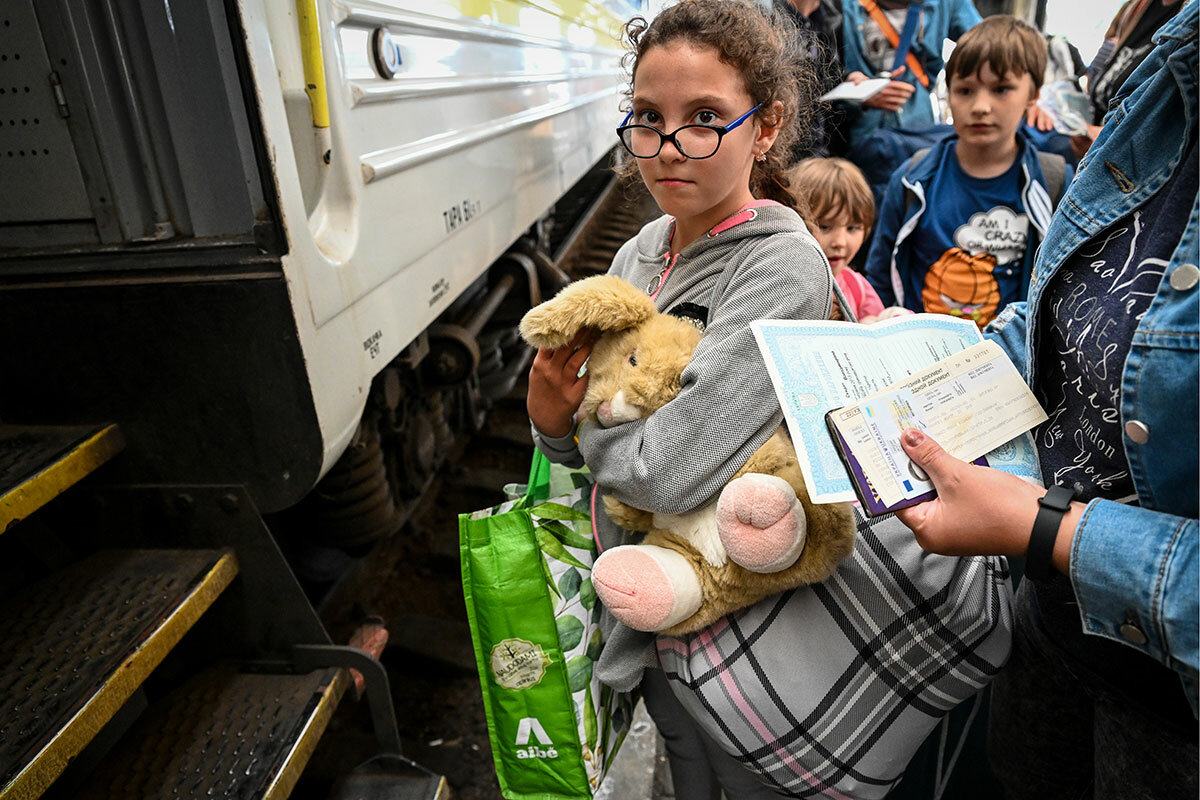‘It wasn’t a home.’ Some Ukrainians leave refuge abroad to head back.
Loading...
| LVIV AND KYIV, UKRAINE
Olga Rostovska sits at a tiny kitchen table and shows a picture on her phone of where she wants to be: a partially burned apartment building 400 miles away.
“I cried when I knew Russians damaged my house,” she says, sitting next to her sister, Lyudmila Skidan, whose family she and her children live with in Kyiv. “That’s why I want to move back home so much. I hope that I can fix all this and live there.”
Ms. Rostovska is from Kramatorsk, a city in eastern Ukraine now less than 50 miles from the front lines. As in cities across the Donbas region, Kramatorsk’s citizens have a group chat – where they post news of shelling and prayers for normalcy – on the messaging app Telegram.
Why We Wrote This
A story focused onThough the war in Ukraine rages, some of the millions of refugees who fled are eyeing going back. The fighting may be a threat, but for them, the call of home may trump the safety of a foreign land.
Each day, she hopes to read that her city is safe again. She and her two young children evacuated in April, first to Ukraine’s west, then to Lithuania for two months, and then back to Kyiv. Now they want to go home – even if Russian shelling means there isn’t much home left.
Russia’s invasion this February began an exodus of refugees to western Ukraine and the surrounding countries. Some 7 million Ukrainians are now displaced within their own country, and another 5 million crossed the border and became refugees around Europe.
But many of them want to come home. Between Feb. 28 and June 21, according to the United Nations, there have been nearly 3.6 million “cross-border” movements back into Ukraine. The number of refugees included in that total isn’t recorded, but cities like Kyiv are gradually recovering their prewar populations. It seems as though many Ukrainian refugees are now returning, at least temporarily.
Especially during war, refugees move according to a number of different push-and-pull factors. On one end, fleeing to a new nation – with a different language and culture – can be taxing. On the other, despite brutal missile strikes, most areas of Ukraine are now safer than they were at the beginning of the war, when Russia was attacking on many fronts. Some Ukrainians may be judging that life abroad is too difficult and life back home is safe enough. For many, like Ms. Rostovska, home is worth the risk. “We never wanted to leave,” she says.
Relocation after relocation
To Ms. Rostovska, home is Kramatorsk’s parks and town squares. It’s her kids’ schools and her job at a maternity ward. It’s the short walk to see her sister, niece, and nephew.
And since 2014, home has also been war.
Kramatorsk was one of the cities threatened when Russia-sponsored separatists began their uprising in the Donbas eight years ago. “We got used to this kind of war situation,” says Ms. Rostovska. “So we took a long time to decide to leave.”
The number of civilian buildings being hit by artillery eventually convinced her to go. On April 7, Ms. Rostovska went to the Kramatorsk train station with luggage and her two young children. It was packed, and she considered leaving to try again the next day. But a woman on the platform noticed her indecision and convinced her to keep at it, and helped carry her family’s bags until they got a train out of the city. The next day, the station’s platform was bombed.
Ms. Rostovska and her children settled temporarily in Kyiv and on Facebook found someone helping evacuate refugees to Lithuania. She contacted her sister, Ms. Skidan, who had already fled to western Ukraine and couldn’t find work. They met in Lviv with both their families and left the country by bus.
In Lithuania, the two sisters and their four children lived in a rural convent sheltering dozens of Ukrainian refugees. After going to a job fair, they found work at a bottle factory more than an hour and a half away. Locally, their kids continued school and kindergarten.
But the convent only allowed visitors to stay for two months, and rent in Lithuania was expensive. The sisters struggled with the commute and the cold and the area’s many mosquitoes. Ms. Skidan missed her husband of 17 years, who found a job in Kyiv after they evacuated in April. The two had never been apart so long.
“It wasn’t a home,” says Ms. Skidan. “It’s really hard when you don’t understand the language and another culture.”
“Better than nothing”
The two sisters’ situation is in some ways typical, says Aliona Karavai, co-founder of Insha Osvita, a nongovernmental organization in Ukraine that serves refugees. Transitioning to a new country is hard in the best of times, and a war is nearly the worst. Many people struggle with work, child care, language skills, and community. Those factors can make it hard to stay.
“You’re physically safe, but you are socially unsafe,” says Ms. Karavai, whose organization is starting a program to support returning Ukrainians.
There aren’t clear statistics on the number of refugees now returning. But anecdotal evidence suggests it’s high. On the Polish border, there’s a miles-long queue of cars waiting to reenter Ukraine.
In mid-June, Ms. Rostovksa and Ms. Skidan again filled their bags – some of them weighing more than 75 pounds – and crossed that border on a bus. They settled in Kyiv, where Ms. Skidan’s husband had already signed on a short-term apartment near an outdoor auto shop. For the seven of them, there are only two bedrooms.
“Better than nothing,” says Ms. Rostovska.
Hoping to stay in Kyiv only a month, both sisters wait and watch for good news from home. On the group chat, Kramatorsk’s teachers recently said they wished students could come back in the fall.
Meanwhile, Russia’s military recently took Lysychansk, less than 100 miles away. Kramatorsk may be one of the next cities targeted. Ms. Skidan’s husband tells her, “There will be no life in Kramatorsk in the closest years.”
The families are now officially registered as internally displaced. None of them are willing to put their children – who step into their apartment kitchen to hug their mothers or grab a slice of apple pie – at risk. Kyiv is expensive, they say, but one month may have to become two, or longer.
Ms. Skidan sits next to her sister and 14-year-old son. Magnets hang on their refrigerator, and cinnamon cookies lie untouched on the kitchen table. Her pink shirt says “positive thinking” in cursive.
“Home is your walls,” says Ms. Skidan. In Lithuania, while she and her family adjusted to sleeping in beds after months spending nights in the hallways of their home in Kramatorsk, she imagined coming back to her husband. This is the first year of her life, of her children’s lives, that they didn’t celebrate Easter with family together. It’s the first year they didn’t visit the cemetery where their grandmother is buried.
Now she, her husband, and her family are all together again. But they’re not home, she says, starting to cry. Her son reaches back and puts his hand on hers. Often Ms. Skidan dreams they have returned to their apartment and things are safe again. But for now, she still waits.
Oleksandr Naselenko in Lviv and Olya Bystritskaya in Kyiv supported reporting for this story.








